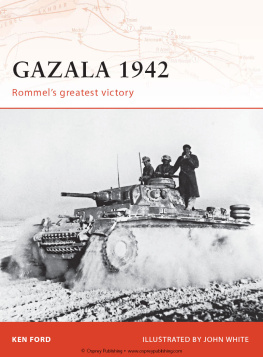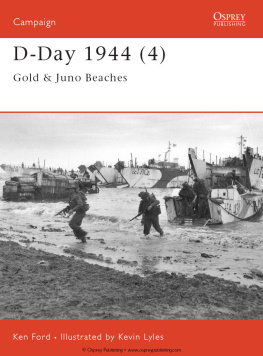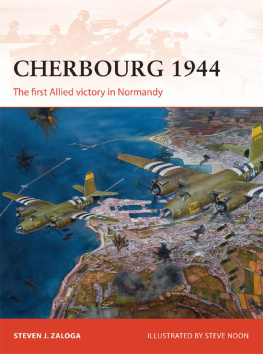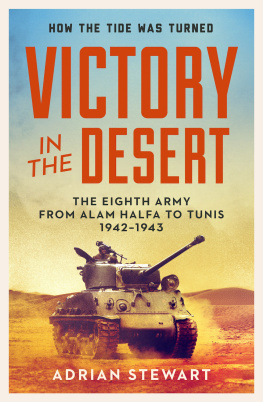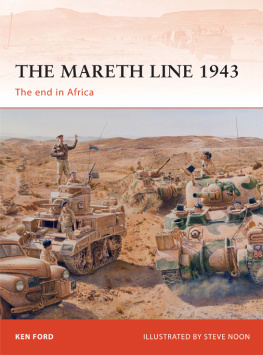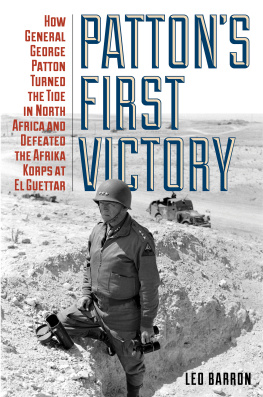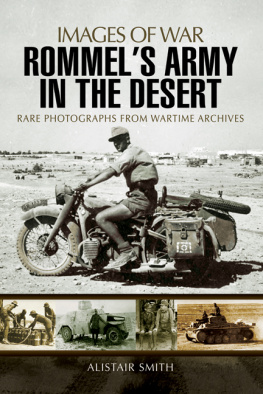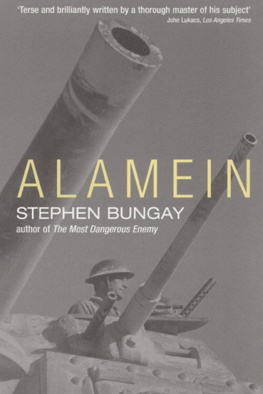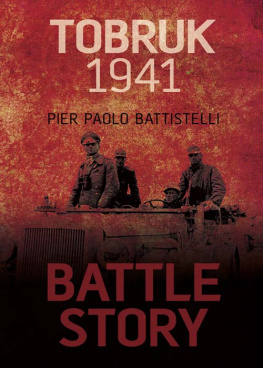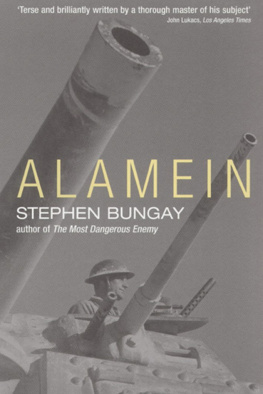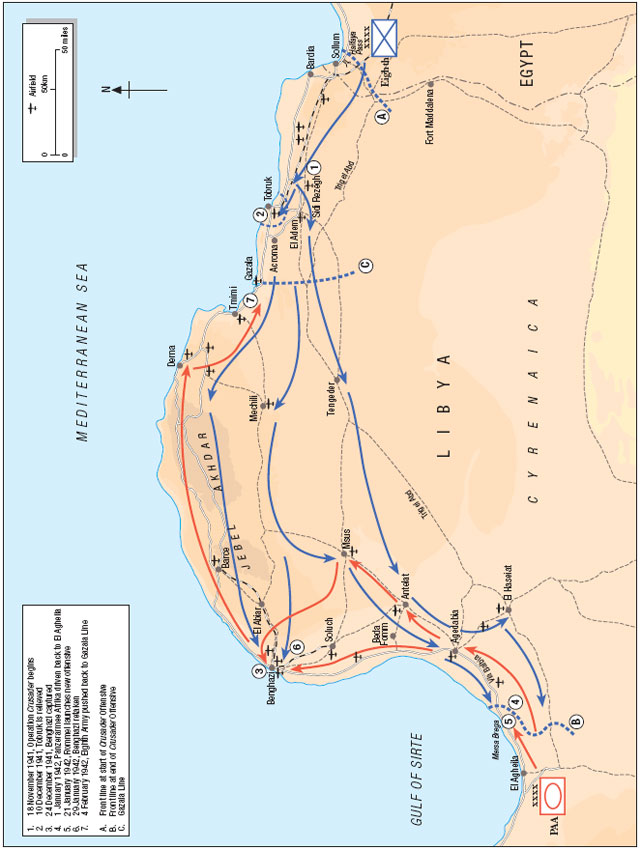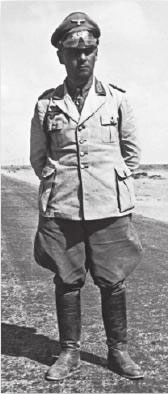ORIGINS OF THE BATTLE
The start of 1942 marked the third calendar year of the war in the North African desert. What had begun as border skirmishes between two colonial powers on 11 June 1940, the day after Italy had declared war on Britain, later developed into a full-scale theatre of war which pitted British and Commonwealth forces against the fascist empire of the Axis regimes.
It had all started so well for General Archibald Wavells sparse Western Desert Force. His two divisions pushed the seven divisions of Grazianis Italian Tenth Army back across Libya to El Agheila at the base of the Gulf of Sirte, capturing great numbers of troops and equipment in the process. Wavells force was then plagued by the same problems that were to affect both sides throughout the desert war; how to supply their armies on the front line when their supply trains stretched back hundreds of kilometres in the rear? Everything from ammunition to toilet paper had to be ferried forwards across featureless terrain, along poor roads and through shifting desert. The farther west the British advanced, the longer the supply train grew, sucking in more and more men and transport just to keep those at the front sustained.
Operation Crusader: Eighth Armys advance to El Agheila and retreat back to the Gazala Line
Generalfeldmarschall Rommel strikes a defiant pose for the camera on the main coastal road across Libya to Egypt, the Via Balbia, which formed the main axis for the to-and-fro battles that took place in North Africa between 1940 and 1943. (IWM, HU5623)
Wavell paused at El Agheila and tried to build his strength prior to resuming his westward advance. By this time his force had become XIII Corps under the command of Lieutenant-General Richard OConnor and comprised 6th Australian Division and 7th Armoured Division. At this point Axis forces invaded Greece and Prime Minister Churchill instructed Wavell to send part of his strength to help counter enemy forces there. Lieutenant-General OConnor was ordered to relinquish the Australian Division and part of 7th Armoured Division, which left him with few forces to hold the line. Worse was to follow when Hitler came to the aid of his Italian ally and dispatched Generalleutnant Erwin Rommel to North Africa in a bid to restore some prestige to the Axis cause. With Rommel came the fledgling units that were to form the Afrika Korps just part of the 5.leichte Division and elements of 15.Panzer Division but they were enough to bolster the Italians into launching an attack against the British on 24 March 1941.
With Rommels armoured cars leading the assault, Axis forces pushed the British XIII Corps right back to the Egyptian border and, by 14 April, had cleared the whole of Cyrenaica save for a beleaguered garrison of two Australian brigades holed up in the port of Tobruk. The rapid advance now left Rommel with long supply lines to the rear and little extra strength, fuel or ammunition to push farther eastwards into Egypt. His advance halted at the Halfaya Pass. In contrast, Wavells forces had short lines of communication and were growing stronger by the day as new formations arrived in Egypt from Britain and the Commonwealth.
Wavell struck back on 15 May with Operation Brevity in which he tried to repossess the strategically important Halfaya Pass. Initially, the attack was successful, but within 12 days Rommel counterattacked and took it back again. Wavell tried again on 15 June with a more ambitious strike named Operation Battleaxe. The results were the same: Rommels defensive tactics had the measure of the attack and the battle was virtually over in just two days with the vital pass remaining in Axis hands. Rommel had the strength to resist the British, but had little extra might with which to force his way into Egypt. Reinforcement seemed unlikely, for seven days later Hitler launched his attack on Russia and the Afrika Korps slipped down the list of German priorities.
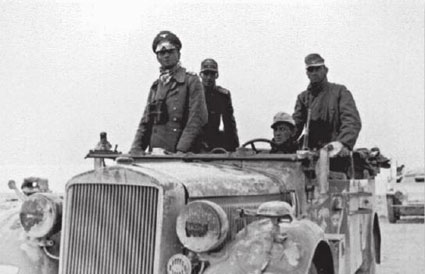
25 November 1941 and a tired and dispirited Rommel stands in the front of his Horch staff car during the great retreat after his defeat by the British during the Crusader offensive. (US National Archives)
Churchill now lost patience with Wavell and replaced him with General Sir Claude Auchinleck. During that summer the Western Desert Force was enlarged by the addition of XXX Corps and became Eighth Army with Lieutenant-General Alan Cunningham, recent victor against the Italians in Abyssinia, in command. A new, much larger offensive, Operation Crusader, was planned to begin on 18 November. This time Auchinleck and Cunningham would begin by trying to outflank Rommels positions at the Halfaya Pass and drive through to Tobruk. At the same time, the Tobruk garrison would break out of its encirclement to join up with Eighth Army. While this offensive was being planned, Rommel himself was organizing his own attack aimed against Tobruk, convinced that the British posed no serious threat to him.
Cunningham struck first and succeeded in launching XXX Corps behind the enemy at Halfaya Pass and swung out into the desert. Rommel met this attack at Sidi Rezegh and caused great damage to the inferior British armour, destroying the bulk of XXX Corps tanks. The German commander now had an opportunity to annihilate XXX Corps, but chose to attempt a greater victory by attacking eastwards in an effort to get behind the rear of Eighth Army and cut its line of retreat in order to destroy it completely.
The move unnerved Cunningham who then urged Auchinleck to sanction a general retreat. Auchinleck was made of sterner stuff and refused to give way, reasoning that Rommels forces must now be tired and in as bad a way as the British. He ordered every unit to attack the enemy and to pursue him relentlessly and then replaced Cunningham with his own Deputy Chief of Staff, Lieutenant-General Neil Ritchie. Rommels attempt to disorganize the British partially succeeded, but it also caused some confusion within his own army. He failed to achieve his plans on two counts: he was not strong enough to break the British positions, nor did he have sufficient forces opposite Tobruk to hold the British down in his rear.
Although Ritchie was titular head of Eighth Army, it was Auchinleck who now directed the course of the battle with orders for a resumption of the attack on Sidi Rezegh. The move unbalanced the Axis command for Rommel was still well to the east and out of touch with his main headquarters. Days of intense and confused fighting followed as Rommel tried to take back the initiative. Great damage was suffered by both sides fighting furiously to gain control of the battlefield. Ritchies troops pushed on to Tobruk and managed to lift the siege. Gradually the superior strength of the British began to overcome Rommels command and the Afrika Korps was in danger of being surrounded. Rommel tried one last attack to break through into Tobruk on 5 December but it failed. The next day he ordered a general retreat.
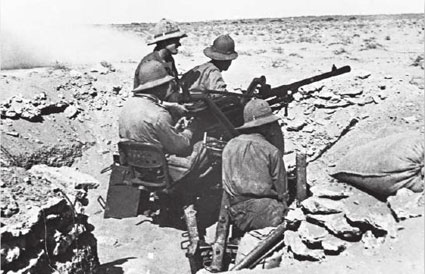
Italian troops man a Breda 20/65 model 35 cannon. This 20mm gun was designed in 1934 as an anti-aircraft weapon, but had a dual role in the desert where it served as an anti-tank gun, albeit with a poor reputation and inferior performance when compared with most other weapons. (IWM, MH5867)

